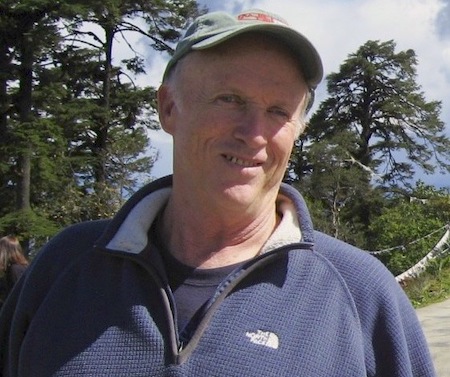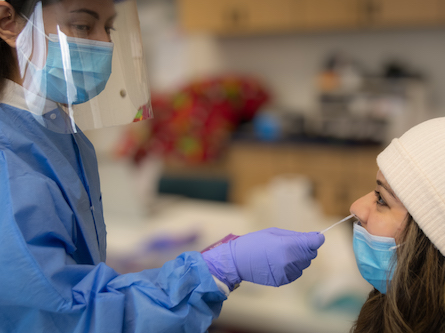By Ed Kissam.
Tremendous progress has been made in the battle against COVID-19 in the 2 years since it was recognized in March, 2020, that we were confronted with a pandemic. But now, with highly effective vaccines and more widespread availability of COVID-19 testing, we’re finding ourselves in a moment of calm—a good point for reflection and planning.
Despite the remarkably successful national response to the pandemic, the reality is that, with at least 80 million officially recorded cases and close to 1 million COVID-related deaths, the battle continues. From very early on in the pandemic, it was recognized that low-income communities, people living in crowded households, latinos, and farmworkers were experiencing a heavy burden—with infection rates and deaths at least 1.5 times higher than the average American.
Two closely-linked strands of development (one stemming from medical research, one stemming from forward-thinking policy) -- deserve careful attention at this point. In the middle of 2021, effective monoclonal antibody treatments that could prevent COVID-19 infection from progressing to serious illness, hospitalization, ICU admission, and death began to be available. By November, 2021, two highly-effective treatments—Molnupiravir and Paxlovid—became available and were rightly seen as tremendously promising.
On March 1, 2022, President Biden. announced a new, bold, set of initiatives. One, in particular, the President’s “Test To Treat” initiative—a plan to make the highly-effective new antiviral pills available to all Americans-- holds out particular promise for UC Davis’ ongoing efforts to address health disparities related to COVID-19.
However, there remain major challenges in effectively implementing the “Test to Treatment” plan in the most disadvantaged communities. UC Davis can play a key role here—piloting and demonstrating ways to make this part of the national plan a reality in the farmworker and other low-income rural communities of the Central Valley.
But how to make “Test-To-Treat” work for communities that have historically had inequitable and uneven access to health services? UC Davis can, as it expands its’ mobile van service to outlying rural communities of farmworkers and immigrants, at the same time, extend the scope of services provided to include the health education, screening, and rapid case management and referral needed to make “Test To Treat” a reality for the vulnerable populations it serves.
UC Davis has been a leader in improving access to rapid-turnaround testing and vaccination in California farmworker communities in the Central Valley. Reliance on mobile vans and partnerships with grassroots community-based organizations to bring help closer to farmworkers and low-income rural families has attracted notice in California, and nationally, as an effective approach for responding to the needs of these disadvantaged families. The ORALE COVID-19 mobile van project, initiated in September, 2020, has served thousands in rural communities in Yolo, Stanislaus, Madera, and Fresno counties while the newer MOVE IT UP initiative has extended that support to vulnerable population in urban Yolo and Sacramento County. UC Davis can build on this solid foundation to re-design its’ vans’ services to become “points of care”, providing “one-stop shopping” for those it reaches out to serve.
Challenges in making antiviral treatment available to high-risk farmworkers and immigrants
President Biden’s broad vision of "Test To Treat" assumes everyone in the U.S. has access to a primary health care provider or, if not, that they can go to a local pharmacy to get a prescription for antiviral medication. It’s an attractive vision but the devil is in the details when it comes to making the approach work in rural farmworker communities.
What are the challenges that will need to be overcome?
Challenge #1: Access to antiviral treatment will continue to be limited—for months to come. Current CDC guidelines quite understandably require a form of triage in access to treatment—priority to infected patients who are the highest risk—due to age, co-morbidities, being immunocompromised, or lack of vaccination (none, partial, or un-boosted). However, although about half of all farmworkers would be considered “high risk” and eligible for priority access, about the same proportion (40%) lack health insurance and/or have not visited a primary health care provider for 2 years or more. Inevitably, many who are, in fact, “high risk” may not know it and, therefore, may not seek treatment. Some may suspect they are “high risk” (e.g. an unvaccinated, overweight 50 year-old worker who worries he has diabetes but who has never been diagnosed).
Challenge #2: Access to antiviral treatment is most effective for high-risk patients if it is initiated as soon as possible after the patient has tested positive or begun to show symptoms —in any case within 5 days after symptoms appear (as required by label instructions for both Molnupiravir and Paxlovid).
Challenge #3: The administration’s "Test To Treat" strategy requires pharmacists to be adequately trained and prepared to prescribe and dispense antiviral pills based on consideration of a person’s health history and conditions. In particular, there are, for the most effective antiviral, Paxlovid (90% protection against progression to hospitalization), some significant counter-indications. Molnupiravir, which is less effective but still valuable (30% protection against hospitalization) is, however, an alternative if Paxlovid is not appropriate. The American Medical Association argues that only MD’s are adequately trained to reliably assess appropriateness although the administration and other experts argue that pharmacists can be adequately trained. In either case, it is likely that few pharmacies in rural farmworker communities will have the trained staff required for patient assessment.
What can ÓRALE and MOVE IT UP do to move forward?
UC Davis’ mobile van outreach to farmworkers and their families has already been shown to be a popular and cost-effective approach to serving hard-to-reach households. Current services to make rapid-turnaround testing and vaccination easily available to vulnerable populations can be expanded rapidly and systematically.
Next Step: #1 Build awareness of high-risk conditions for serious COVID-19 illness and the availability of highly effective treatment. UC Davis mobile van staff can be rapidly prepared to provide crucial health education on factors that lead to serious COVID-19 illness, the availability of highly-effective easily-used treatment (a short course of treatment with pills), and the absolute necessity of light-speed action to access treatment
Next Step: #2: Initiate screening to Identify farmworkers and family members who are high risk but don’t know it UC Davis staff can be rapidly prepared to present basic information on common factors that contribute to high risk of serious COVID-19 illness (age, overweight or obesity, diabetes, cardiovascular disease, chronic lung disease, lack of vaccination and/or boosting, pregnancy, chronic liver disease—alcoholic or NASH, immune suppression. Initial health education on risk factors can serve as the springboard for referral to health care screening.
Next Step: #3 Build partnerships to facilitate “lightspeed” access to antiviral treatment Partnerships will need to include arrangements with community health clinics and providers to provide instant access after a mobile van positive test to prescription and filling of antiviral medication. Some experts argue—very wisely—that it would be valuable to embark on a program of pre-screening and pre-authorization of antivirals for individuals determined to be high-risk for serious COVID-19. Partnerships may also include prior arrangements with pharmacies that are prepared to assess patients and prescribe antivirals.
The bottom line: start now to build alliances to make "test-to-treat" viable
It is not realistic to assume that UC Davis can immediately implement all the steps necessary to make rapid access to COVID-19 treatment available to all farmworkers and immigrants. A recent study showed, quite depressingly, that the highest-risk Medicare patients were much less likely than low-risk Medicare patients to secure access to treatment with monoclonal antibodies (antivirals were not yet available). Systemic change is crucial—but never instantaneous.
The mobile van outreach approach provides a unique opportunity for UC Davis to lead the way in the operational development of effective approaches to make the Biden administration’s vision of Test-To-Treat a reality. The resources required to move forward are significant but the stakes are high and the return on investment will be dramatic. Successful implementation of provisions to assure rapid access to treatment for the vulnerable farmworker and rural immigrant population will decrease hospitalization costs, mitigate the economic impact of COVID-19 on poor families by hastening recovery, avoid deaths among the “working poor” who are, due to lower rates of vaccination and boosting most vulnerable.
The White House, “National COVID-19 Preparedness Plan”, March 1, 2022. https://www.whitehouse.gov/covidplan/
US Department of Health and Human Services. https://www.hhs.gov/about/news/2022/03/08/fact-sheet-biden-administration-launches-nationwide-test-treat-initiative-ensuring-rapid-on-spot-access-lifesaving-covid-treatments.html
CDC, “The COVID-19 Treatment Guidelines Panel’s Interim Statement on Patient Prioritization for Outpatient Anti-SARS-CoV-2 Therapies or Preventive Strategies When There Are Logistical or Supply Constraints”, most recent update December 23, 2021.
Pfizer, Inc, “Fact Sheet for Health Care Providers: Emergency Use Authorization For Paxlovid”
AMA Statement on administration’s test-to-treat plan, March 7, 2022. https://www.ama-assn.org/press-center/press-releases/ama-statement-administration-s-test-treat-covid-19-plan
Behr et. al, “Anti–SARS-CoV-2 Monoclonal Antibody Distribution to High-risk Medicare Beneficiaries, 2020-2021”, JAMA, February 4, 2022.
The New York Times. https://www.nytimes.com/interactive/2021/us/covid-cases.html accessed March 13, 2022.

Ed Kissam is a retired researcher and evaluation expert whose work has focused on immigrant settlement and adult learning. He is currently a trustee of the WKF Fund, a small charitable-giving organization, and member of the National Center for Farmworker Health Advisory Committee to the CDC, an initiative focused on fighting COVID-19 in agricultural communities across the U.S.



